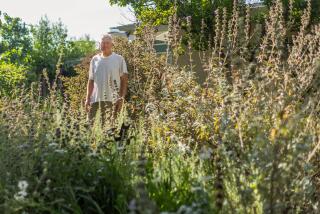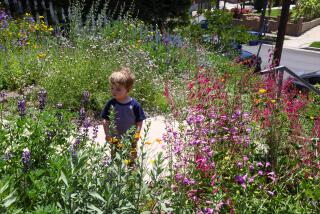Staggering the beauty
- Share via
IN the presence of cold and absence of rain, somehow spring is still happening. As is the peculiar nature of the season in Southern California, it has been underway for some time now.
What’s clear to the gardener, however, is that it’s not happening in its usual order. January dandelions that pop up under discarded Christmas trees were right on cue. Saucer magnolias produced their fragrant pink cups on schedule in February. Coral bells have been casting off their first spires for a month.
But hedges have yet to sprout luminous new tops, apricot trees have remained bare-branched, irises are skulking, and native lilac blossoms are playing peek-a-boo with the bees.
If there is a benefit to this fitful start, it is the view afforded to the mechanics behind spring bloom. Warm, wet years produce such riotous abundance that it’s hard to focus. By contrast, the austerity of 2007 is revealing the endlessly individual ways in which the plants in our gardens react to three simple triggers: light, heat and water.
The most reliable harbingers of spring are the most light-sensitive plants. These are the ones that show up on time, in years cold and warm. The prod is called photoperiodism, a phenomenon in which a certain combination of lightness and dark get plant hormones firing and blooms started.
Lettuce and artichokes, along with their dandelion cousins, respond with uncanny precision to the amount of light they receive. This sensitivity accounts for the failure of even the most skilled gardeners to grow lettuce outdoors in summer. It will bolt the moment the length of day signals the end of its season.
It’s easy to miss the time-keeping of these plants in years when water and warmth give them florid competition. In good years, one rarely hears praise for the city’s leggy, red-tipped imps, naturalized poinsettias. This season, these light-driven specimens seem less like bad planting decisions than godsends.
Poinsettias’ bracts redden at Christmastime in the tropics (and in greenhouses). Yet their signature “flowering” habit here amounts to a geography lesson. Planted outside in gardens at the latitude of about 34 degrees north and longitude of about 118 degrees west, or in Los Angeles, they mark Christmas in March.
SPRING’S larger show hasn’t all been lost. Much of it is merely stalled, waiting for heat. Temperature, above all other triggers, is the most important jolt from dormancy for most plants, says John Fellman, a plant chemist at Washington State University. He likes to drive home the point to his students using the proverb of the Seneca Indians: “You should not even bother to plant your maize until you can sit bare cheeked on the soil.”
Warm weather is the defining influence on the blossoming time of stone fruit trees, says UC Davis professor of tree fruit physiology, Ted DeJong. Those worried about skulking apricots, plums and peaches should relax. Bloom time can vary by as much as a month, depending on the weather.
Moreover, cold winters are a good thing for this class of plant. The relatively long dormancy will have them rested and ready for a glorious, sudden spring blossom.
“While the temperature stays in the 50s, they’re not going to do much,” DeJong says. “Give them a nice run of days between 68 and 75 degrees, and, boom, they’ll pop.”
A quirk of these trees makes the moment they pop feel like the official start of spring. Why cherries, apricots, peaches and plums emerge from dormancy with blossoms before foliage is anyone’s guess, but they do. Given the drought, it is tempting to water them as the pink and white clouds finally form. But experts warn against it.
Fellman explains: Although most plants grow foliage first and therefore need water for leaves to conduct the photosynthesis that will feed the bud and fruit formation, the naked blossomers work differently. They manage their exhibitionism by using reserves stored in the roots during the winter.
The time to water them is after the leaf canopy forms, DeJong says. Once quenched, those leaves will take over energy production to drive fruit formation in what looks like a promising year.
Water, of course, is the final determinant of the spring flush, and with rain conspicuously scarce, the outlook for wildflower season is bleak.
Barring what Cal Poly Pomona biology professor Curtis Clark calls a “March miracle,” or almost a year’s worth of rain in a month, the poppy show in the Antelope Valley promises to be “close to nonexistent.”
Although established poppies that managed to over-winter have ways of coping with drought, the seeds require a critical amount of water to germinate. Scant showers aren’t enough. Repeated soakings are what allow the germinating seed’s cells to swell with a force that will send roots feet deep into the soil. Without an eleventh-hour dousing, dormant seeds will have to wait for a more clement season.
It doesn’t look much better for lupines, five spot or clarkia. Photographer Carol Leigh runs a website, www.calphoto.com/wflower.htm, dedicated to wildflower spottings across the state. She says the outlook is dicey.
“You could have a very delayed but wonderful season,” she says, “but I wouldn’t count on it.”
THIS does not prevent a wildflower display at home, within reach of a hose. Yet beyond showering tender annuals, caution is in order for gardeners trying to compensate for the only variable they can control of the light, heat and water trinity.
Not only is L.A. quiet on flowers this years, its hedges are muted. The typical capping of luminous spring growth is largely missing. The temptation to force it with irrigation is borderline irresistible. But try not to.
Few common garden plants are as robust as the ficuses, box hedges, Texas privets, bays, photinias and conifers that make up most of our hedges. The best way to help them ride out a dry spring and foreboding summer is to follow their suit and allow growth to slow to a standstill.
The most benefit will come from what we don’t do. Stop pruning, then allow the plants to flower briefly and slip into dormancy.
The reward will be a brief burst of perfume and respite from buzz saws. As summer progresses, water rarely and deeply if there are signs of stress.
Ditto for roses, which are brambles at heart and can survive on very little water. They will erupt healthier than ever with the next good storm.
This rainy season looks headed for the record books as a bust. In such a cold, dry year, there certainly will still be color and scent.
Yet only a fool would promise a gangbuster spring show as March and April unfold.
That said, what a restrained season affords is no less valuable. It took frost and drought to consider how good we normally have it.
It may take frost and drought to illustrate the underlying glory of how plants work and why no two springs are the same.
*
(BEGIN TEXT OF INFOBOX)
How to find growing tips
Here are resources for seasonal gardening advice:
Wildflowers: To track the season, call the Theodore Payne Wildflower Hotline at (818) 768-3533 from March through May. www.theodorepayne.org.
Fruit trees: UC Davis has information for backyard growers at fruitsandnuts.ucdavis.edu.
Photoperiodism: John W. Kimball is a retired Harvard professor and author of seminal biology texts. As part of the Textbook Revolution project, he updates these books online in Kimball’s Biology Pages. For the link to his page on photoperiodism and the biological processes behind blooms, go to users.rcn.com/jkimball.ma.ultranet/BiologyPages/P/Photoperiodism.html .
-- Emily Green






